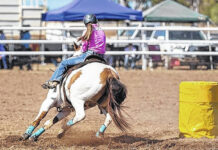
The Cat in the Hat made an appearance on March 3, 2015, at Rosenwald Elementary and other schools across the district as part of Read Across America — an annual event that celebrates Dr. Seuss’ birthday by promoting literacy. Born Theodor Seuss Geisel, the beloved children’s author would have been 111 years old.
THIS WEEK IN HISTORY
Robeson County History
20,000 Robeson children learn about miIk today: On March 6, 1924 (100 years ago), The Robesonian reported that the food value of was milk stressed by speakers in each of the 109 schools of the county. Window displays in nine towns set forth comparative values.
Record marijuana haul confiscated; 3 arrested: The March 6, 1924 (100 years ago) Fifteen and three-quarters pounds of marijuana, packaged, ready for sale, and with a street value of $8,000 was confiscated Friday around 9:30 p.m. by Robeson County Deputies and an SBI agent, when they arrested three men at an I-95 rest stop. Deputies Ray Priest, Luther Sanderson, Garth Locklear and D. A. Parnell, along with SBI Agent Frank Johnson, working on information resulting from their own investigation, made the arrest and confiscation.
North Carolina History
Cherokee Attack on Fort Dobbs: On Feb. 27, 1760, Fort Dobbs was attacked by a force of more than 60 Cherokee warriors. The fort had been constructed four years earlier to protect the western frontier during the French and Indian War.
Fighting between the British settlers and their former allies broke out in 1759 as settlers were killed in revenge for the murder of several Cherokee the year before. As the only permanent fort on the colony’s frontier, the fort served as a safe-haven for settlers, and its garrison of soldiers helped to defend the region.
Colonel Hugh Waddell, the fort’s commander, noted that the Cherokee “found the fire very hot” as ten of his men engaged the Cherokee near the fort around nine o’clock at night. “I ordered my party to fire which we did not further than 12 steps each loaded with a bullet and seven buck shot,” Waddell later wrote. “They [the Cherokee] had nothing to cover them as they were advancing either to tomahawk or make us prisoners…”
Waddell retreated to the fort and the Cherokee broke off the attack. The combined casualties, killed or wounded, from the brief encounter included 12 Cherokee, two soldiers and one settler child.
Driver’s Licensing Began: On February 28, 1935, the General Assembly passed the Uniform Driver’s License Act, placing in the pockets of authorized drivers the state’s official sanction putting them behind the wheel. The bill, sponsored by Senator Carroll Weathers of Wake County, was a response to the fact that more than 1,000 deaths had occurred on the state’s highways since the rise of the automobile 30 years earlier. The automobile age in North Carolina had begun in earnest with the introduction of the “Buggymobile” in New Bern in 1903 and other primitive vehicles soon after.
The 1935 act defined a motor vehicle as “any rubber-tired vehicle propelled or drawn by any power other than muscular.” Aircraft, road rollers, street sprinklers, ambulances, baggage trucks and agricultural and industrial tractors were excluded from the licensing requirement.
A state issued driver’s handbook from 1953
Then, as now, drivers were required to be at least 16 years of age. Initially no test was required, and only the word that the applicant was experienced and careful was needed. Exams began in 1948.
Today the Division of Motor Vehicles, part of the Department of Transportation, administers the state’s drivers licensing program. You can see the original Uniform Driver’s License Act by clicking here.
Governor Thomas Bickett of Monroe and Louisburg: On Feb. 28, 1869, Thomas Bickett, North Carolina’s World War I governor, was born in Monroe.
After studying law at UNC, Bickett settled in Louisburg and was elected to represent Franklin County in the state House in 1906. During his single term in the General Assembly, Bickett made his mark as the sponsor of the “Bickett Bill,” which set aside a half-million dollars to help care for the mentally ill.
Gov. Bickett and his wife stand on the steps of the Executive Mansion.
Drawing attention at the 1908 state Democratic Party convention in Charlotte, Bickett was nominated for attorney general. During his two terms in that office, Bickett successfully defended the state’s interests in numerous state Supreme Court cases and five before the United States Supreme Court.
Bickett was elected governor in 1916, the first year primary contests were held. Three months after his inauguration, the United States entered World War I. Though motivating the public to help the war effort became a major focus of his term, he also helped overhaul the state’s parole system, expand higher education, reform the tax code and increase spending on public health. A strikingly successful politician, Bickett saw the General Assembly adopt 40 of the 48 proposals made during his term.
Bickett died in December 1921 and is buried in Louisburg.
Harnett Basketball Contest in 1964 Had 13 Overtimes. On Feb. 29, 1964, Boone Trail High School held off Angier High School to win the longest high school basketball game on record, 54-52.
The game, that year’s Harnett County high school championship, was played in Campbell University’s Carter Gym. The gym was small in size and could seat only 947 spectators. There is no known record of how many were in attendance that day.
A headline announcing the game’s outcome. After the regulation game ended in a 44-44 tie, the two teams duked it out in 13 overtime sessions, and both teams used only the original five starting players in the game with no substitutions. The teams only scored a combined 18 points in the 13 overtime sessions, and there were nine sessions where neither team scored any points.
Boone Trail’s Frankie Stewart led all scorers with 29 points. Reportedly, one of the Angier players was so superstitious that the coaches told his team to not tell him they were in overtime number 13.
The game began at 8:30 p.m. Saturday and ended just before midnight. With the final buzzer, it just avoided the “no play on Sunday” rule.
Thomas Day of Milton, North Carolina’s Premier Furniture Craftsman. A bureau made by Thomas Day and now in the collection of the N.C. Museum of History
Mount Mitchell, First Among the State Parks: A scenic view of Mount Mitchell, circa 1911.
On March 3, 1915, the General Assembly appropriated $20,000 to purchase Mount Mitchell. It would become the first of North Carolina’s state parks.
At the time, the virgin-growth forests rich with balsam and spruce that once dominated the Black Mountains were quickly disappearing because of a thriving timber trade in the area. The effort to preserve the Yancey County mountain from rampant logging came about, in part, from extensive lobbying by Governor Locke Craig.
At 6,684 feet, Mount Mitchell is the highest peak east of the Mississippi River. It was named for Elisha Mitchell, a science professor who first visited the area around it as part of the North Carolina Geological Survey. In the 1830s and 1840s, he took barometric pressure readings from the state’s tallest peaks and used mathematical formulas to determine their elevations. Until Mitchell’s calculations, New Hampshire’s Mount Washington, only 396 feet shorter than Mitchell was thought to be the tallest peak in the east.
In an unfortunate twist of fate, Mitchell died while exploring the mountain that bears his name in 1857, when he slipped and fell from a cliff, drowning near a waterfall now known as Mitchell Falls.
One hundred years later, the North Carolina State Park System is thriving It now preserves nearly 220,000 acres of North Carolina’s natural beauty at 74 parks, recreation areas natural areas, lakes, rivers and trails and attracted more than 15 million visitors last year.
Lafayette Visits the Town Named in His Honor: An Image of Lafayette from Colonial WilliamsburgOn March 4, 1825, the Marquis de Lafayette visited Fayetteville, a town named for him in 1783. staying at home of Duncan McRae, on site of present courthouse.
Lafayette was a close confidant of George Washington and one of the great heroes of the Revolutionary War. He returned to the United States at the age of 68 on a celebratory tour, and although he originally planned to only visit New England and the mid-Atlantic, he extended his trip to the southern states as well, including North Carolina. While in North Carolina, Lafayette was hosted by his namesake town, Fayetteville, for one night. He stayed at home of Duncan McRae, on the site of the present day Cumberland County Courthouse.
Before arriving in Fayetteville, Lafayette stayed at the Indian Queen Inn in Murfreesboro, visited at the Rocky Mount home of Henry Donaldson and attended a banquet at the Eagle Tavern in Halifax. He also traveled to Raleigh where he visited the Governor Hutchins Burton and William Polk, a veteran of the Revolutionary War.
Fayetteville, incorporated in 1783, was one of the first towns in the newly independent United States named for the Marquis de Lafayette. Read more about Lafayette’s visit on NCpedia.
“Muley Bob” Doughton of Ways and Means: On March 4, 1911, Congressman Robert Lee Doughton launched a 42-year career in the United States House of Representatives. He served 21 successive terms in Congress before voluntarily retiring in 1953, just short of his 90th birthday.
Born in Alleghany County in 1863, he was named for the Confederate general under whom his father served. A farmer by trade, Doughton began a career in public service with his appointment to the state Board of Agriculture in 1903. He then served in the state Senate in 1908 and 1909, before being elected to Congress in 1910.
In Congress, Doughton was appointed to the powerful House Ways and Means Committee. He would eventually work his way up to chair the committee and went on to hold that post for 18 years, longer than any other member. Often called “Muley Bob,” since he was famous for his stubbornness, Doughton was an expert on tax policy. He also took great pride in his role in the preparation and passage of the Social Security Act of 1935, and he was instrumental in the creation of the Blue Ridge Parkway, the ground for which was broken in his home county in 1935.
Doughton died in 1954 in his home in Laurel Springs.
Nation and World History
On Feb. 28, 1993, a gun battle erupted at a religious compound near Waco, Texas, when Bureau of Alcohol, Tobacco and Firearms agents tried to arrest Branch Davidian leader David Koresh on weapons charges; four agents and six Davidians were killed as a 51-day standoff began.
On March 1, 1974, seven people, including former Nixon White House aides H.R. Haldeman and John D. Ehrlichman, former Attorney General John Mitchell and former assistant Attorney General Robert Mardian, were indicted on charges of conspiring to obstruct justice in connection with the Watergate break-in. (These four defendants were convicted in January 1975, though Mardian’s conviction was later reversed.)
On March 2, 1962, Wilt Chamberlain scored 100 points for the Philadelphia Warriors in a game against the New York Knicks, an NBA record that still stands. Philadelphia won the game, 169-147.








